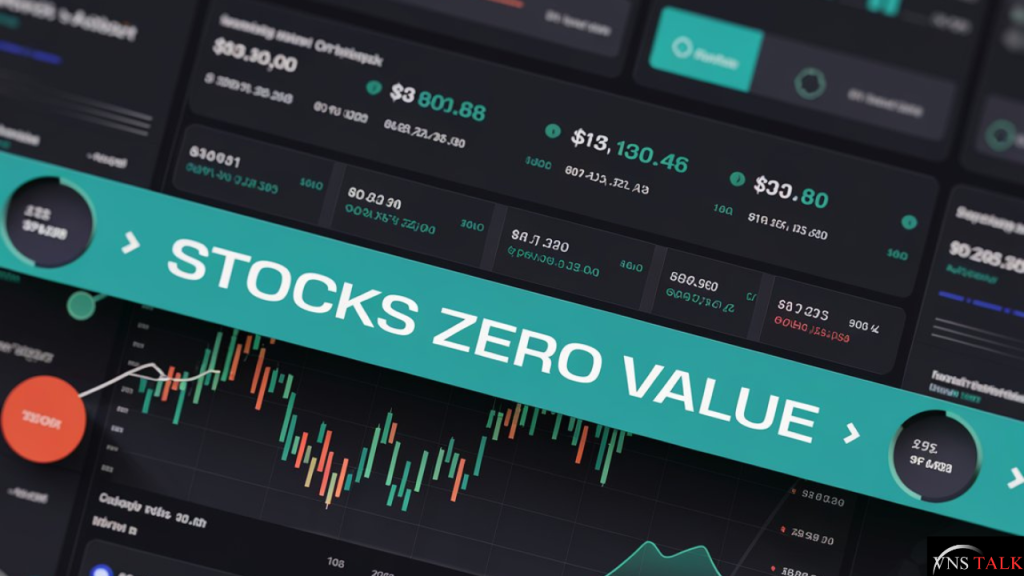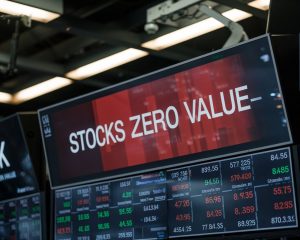Stocks Zero Value: What Happens When Your Stock Reaches Ground Zero?

Stocks Zero Value: What Happens When Your Stock Reaches Ground Zero?
Stocks Zero Value: What Happens When Your Stock Reaches Ground Zero?
Today we will discuss about Stocks Zero Value what happens when your stock reach ground zero ?
When the share price of a company falls to zero, particularly in the case of delivery-based investments, it has severe consequences for investors. Delivery investments refer to buying shares and holding them until sold at a future date. If a stock price drops to zero, it effectively means that the company has lost all its value, and investors suffer complete losses. Let’s break down what happens in such a scenario, using examples and key factors.
Stocks Zero Value : The Scenario & Key Factors
In this section we will discuss deeply about Stocks zero value, the scenario and key factors which affect zero value .
1. Understanding the Consequences of a Stock Price Reaching Zero
If a company’s share price reaches zero, it implies that the company is either bankrupt, has gone into liquidation, or has been delisted from the stock exchange. This is typically the result of prolonged poor performance, insolvency, or extreme market conditions. When this happens:
- Complete Loss of Investment: Investors lose the entire value of their shares. If you bought shares for ₹100,000, and the stock drops to zero, your investment becomes worthless. In the stock market, the value of your investment can never be negative, but you can lose 100% of the invested capital.
- No Compensation for Equity Holders: In case of bankruptcy or liquidation, equity holders (common shareholders) are the last in line to be paid. The company must first satisfy its debt obligations to bondholders, creditors, and preferred shareholders. If there are no remaining assets after these obligations are met, equity shareholders may receive nothing.
Example: Lehman Brothers (2008)
In 2008, Lehman Brothers, a global financial services firm, declared bankruptcy following the subprime mortgage crisis. Its stock price collapsed to near zero, and investors holding Lehman Brothers shares suffered complete losses. Even large institutional investors lost billions, illustrating the devastating effect of a company’s failure on stock prices.
2. Key Reasons Why a Share Price Falls to Zero
- Bankruptcy: A company can file for bankruptcy due to insurmountable debt or poor business performance. Once a company is bankrupt, it often suspends operations, and the stock price declines rapidly.
- Delisting from Stock Exchanges: Companies that fail to meet listing requirements, such as minimum market capitalization or share price thresholds, may be delisted. This causes the stock to lose liquidity, and investors can no longer trade it on mainstream exchanges, leading to significant drops in the share price.
- Fraud and Scandals: Corporate fraud, accounting scandals, or unethical practices can lead to a loss of investor confidence, triggering a massive sell-off. Over time, this can drive the stock price to zero.
- Severe Economic Downturns: During recessions or financial crises, weaker companies may not survive. For example, during the 2008 financial crisis, many companies in the real estate and financial sectors saw their stock prices decline to zero as the markets collapsed.
Example: Enron Scandal (2001)
Enron, once a highly successful energy company, became infamous for one of the largest corporate frauds in history. When the scandal came to light, Enron’s stock, which traded at over $90, collapsed to nearly zero. Investors lost everything as the company went bankrupt, and the stock was delisted from the stock exchange.
3. Impact on Retail and Institutional Investors
- Retail Investors: Individual or retail investors who hold shares in delivery form suffer a total loss. Many retail investors who invest for the long term may not always be aware of impending financial troubles, and the sudden collapse can wipe out their investments.
- Institutional Investors: Institutional investors, such as mutual funds and pension funds, are also affected when stocks drop to zero. While these entities often diversify their investments across many sectors, large exposures to failing companies can still result in significant losses.
Example: Kodak (2012)
Eastman Kodak, once a leader in photography, filed for bankruptcy in 2012 due to its failure to adapt to digital photography. Its shares became virtually worthless, and both retail and institutional investors lost significant amounts of money. Kodak’s failure highlights how poor management decisions and technological disruption can lead to a stock’s price hitting zero.

4. The Legal and Financial Process After a Stock Hits Zero
- Bankruptcy Proceedings: When a company goes bankrupt, it enters a legal process where its assets are liquidated to pay off debts. Equity holders, being last in the priority chain, often receive nothing. The company’s stock may be delisted, and investors will have no way to sell their shares.
- Trading Suspensions and Delisting: Once a stock reaches near-zero prices, exchanges often suspend trading, and the stock can be delisted. Delisted stocks can still be traded in over-the-counter (OTC) markets, but they lack liquidity, and selling them may result in extreme losses.
- Write-offs and Tax Implications: Investors may write off their losses against gains on other investments when a stock becomes worthless, reducing their tax liability. However, this does not compensate for the actual financial loss.
5. Strategies to Mitigate Risks of a Stock Going to Zero
- Diversification: Investors should spread their investments across various sectors and asset classes to reduce exposure to any one company’s failure. Diversified portfolios are less affected by a single stock hitting zero.
- Regular Monitoring: Keeping an eye on the financial health of companies in your portfolio is essential. Key indicators like declining revenues, increasing debt, and management scandals should raise red flags. Investors should regularly review and rebalance their portfolios.
- Stop Loss Orders: Using stop-loss orders can help investors limit losses by automatically selling a stock when it falls below a specified price, preventing further decline.
6. Real-Life Examples of Stock Price Collapse
- Wirecard (2020): The German fintech company Wirecard collapsed after revelations of a massive accounting fraud. Its stock, once valued at over €100, plunged to near zero, and investors lost billions. Wirecard’s collapse was one of the largest financial scandals in Europe, showing how even major companies can quickly lose all their value.
- General Motors (2009): In 2009, General Motors (GM) filed for bankruptcy during the financial crisis. Its stock was delisted, and while the company was eventually restructured, early shareholders lost most of their investments. GM later issued new shares, but the original stock became worthless.
Conclusion
So this is the meaning of Stocks Zero Value ,When a stock’s price drops to zero, investors face complete losses, as their shares become worthless. This can occur due to bankruptcy, delisting, fraud, or severe economic downturns. Historical examples like Lehman Brothers, Enron, and Kodak illustrate how once-prominent companies can fail, leaving investors with nothing. To mitigate these risks, diversification, regular portfolio monitoring, and stop-loss orders are essential strategies for investors. Ultimately, understanding the risks and maintaining a well-balanced investment portfolio can help protect against the catastrophic impact of a stock collapsing to zero.







You made several fine points there. I did a search on the issue and found mainly folks will agree with your blog.